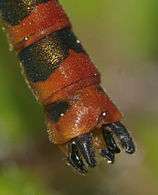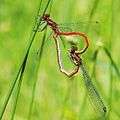Large red damselfly
| Large red damselfly | |
|---|---|
_male_Dry_Sandford.jpg) | |
| Male, Dry Sandford Pit, Oxfordshire | |
_female_form_typica.jpg) | |
| Immature female, form typica, Cumnor Hill, Oxford | |
| Scientific classification | |
| Kingdom: | Animalia |
| Phylum: | Arthropoda |
| Class: | Insecta |
| Order: | Odonata |
| Suborder: | Zygoptera |
| Family: | Coenagrionidae |
| Genus: | Pyrrhosoma |
| Species: | P. nymphula |
| Binomial name | |
| Pyrrhosoma nymphula (Sulzer, 1776) | |
The large red damselfly (Pyrrhosoma nymphula) is mainly a European damselfly, with some populations in Northern Africa and Western Asia.[1]
Habitat
It inhabits ponds and dikes, and occasionally slow-moving rivers.
Identification
Females occur in three colour forms, but all have yellow bands around the abdominal segments. The form typica has more black on its abdominal segments than the form 'fulvipes', particularly segment 6. Immatures have lighter eyes and have yellow stripes on the thorax, not red.
 male appendages
male appendages_female_form_typica_dorsal.jpg)
_female.jpg)
They can easily be confused with small red damselflies, but the latter has orange legs, while the large red damselfly has black legs. In Greece and Albania a closely related species occurs, the Greek red damsel (Pyrrhosoma elisabethae). They look very much the same, the females only having a slightly different pronotum with deep folds in the hind margin. The males differ in their lower appendages, which are longer than the upper ones, while the black hook on the lower appendages is half as long as in the large red damselfly. The appendages of the large red damselfly can be seen in the gallery below.
Behaviour
One of the most common damselflies, the large red damselfly is often the first damselfly to emerge, usually in April or May.
Gallery
 in Belgium natural reserve Marie Mouchon
in Belgium natural reserve Marie Mouchon Mating, Craig-cefn-parc in South Wales
Mating, Craig-cefn-parc in South Wales_male_eating_insect.jpg) male eating insect
male eating insect
Dry Sandford Pit, Oxfordshire video of ovipostion
video of ovipostion
References
- "Pyrrhosoma nymphula - Large Red Damselfly". British Dragonfly Society. Retrieved 28 May 2011.